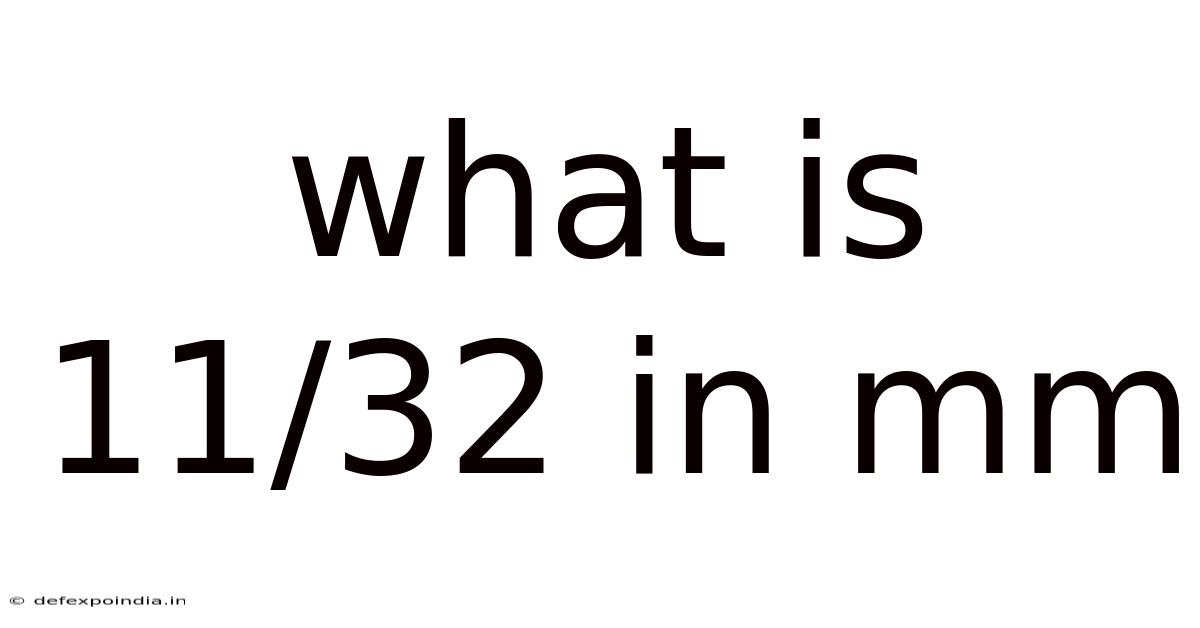What Is 11/32 In Mm
defexpoindia
Sep 21, 2025 · 4 min read

Table of Contents
What is 11/32 of an Inch in Millimeters? A Comprehensive Guide
This article provides a detailed explanation of how to convert the fractional inch measurement 11/32 inches into millimeters (mm). We'll cover the conversion process step-by-step, explore the underlying principles, and delve into the practical applications of such conversions in various fields. Understanding this conversion is crucial for anyone working with measurements in both imperial and metric systems, from machinists and engineers to DIY enthusiasts and designers.
Understanding the Conversion Process: Inches to Millimeters
Before jumping into the specific calculation for 11/32 of an inch, let's establish the fundamental relationship between inches and millimeters. The conversion factor is based on the definition of an inch in relation to a meter:
- 1 inch = 25.4 millimeters (exactly)
This is a universally accepted conversion factor, ensuring consistency across different measurement systems. This means that any inch measurement can be converted to millimeters by multiplying the inch value by 25.4. Conversely, to convert millimeters to inches, you divide the millimeter value by 25.4.
Calculating 11/32 of an Inch in Millimeters
Now, let's apply this knowledge to convert 11/32 of an inch to millimeters. We can break down the process into these steps:
-
Convert the fraction to a decimal: The fraction 11/32 represents a part of a whole. To convert it to a decimal, divide the numerator (11) by the denominator (32):
11 ÷ 32 = 0.34375 inches
-
Multiply by the conversion factor: Now, multiply the decimal inch value (0.34375 inches) by the conversion factor 25.4 mm/inch:
0.34375 inches * 25.4 mm/inch = 8.73125 mm
Therefore, 11/32 of an inch is equal to 8.73125 millimeters.
Practical Applications and Significance
The ability to accurately convert between inches and millimeters is crucial in numerous fields:
-
Manufacturing and Engineering: In industries like machining, manufacturing, and engineering, precision is paramount. Converting between inch and millimeter measurements ensures accurate production of components that need to fit together seamlessly, regardless of whether the original design was in imperial or metric units. A slight error in conversion can lead to significant problems in the final product. This is particularly relevant for tasks like creating threads, designing mechanical parts, and working with blueprints that might use different measurement systems.
-
Construction and Architecture: Construction projects often involve components from different manufacturers or countries, using either imperial or metric units. Accurate conversion is essential to avoid misalignments and ensure structural integrity. This applies to everything from the dimensions of bricks and lumber to the precise placement of reinforcement bars in concrete structures.
-
3D Printing and CAD Modeling: Many 3D modeling and printing software packages allow users to specify dimensions in either inches or millimeters. Knowing how to convert between the two is essential for creating accurate models and ensuring that the final printed object is the correct size.
-
DIY and Home Improvement: Even for home improvement projects, accurate measurements are crucial. Whether you're working with woodworking plans, plumbing fixtures, or electrical wiring, understanding the conversion ensures a successful outcome and avoids costly mistakes.
Understanding Significant Figures and Rounding
In many practical applications, it's not necessary to retain all the decimal places in the converted value (8.73125 mm). The number of significant figures you need depends on the precision required for your specific task.
-
High-Precision Applications: In fields like micro-machining or scientific research, maintaining several decimal places is crucial for accuracy.
-
General Applications: For most everyday tasks, rounding to a reasonable number of decimal places is sufficient. Rounding 8.73125 mm to three decimal places would give you 8.731 mm. Rounding to two decimal places would result in 8.73 mm. The level of precision required dictates the appropriate rounding.
Frequently Asked Questions (FAQ)
Q: Why is the conversion factor 25.4 mm/inch?
A: This factor stems from the official definition of the inch in the metric system. It's an exact value, ensuring consistency in conversions.
Q: Can I use online converters for this?
A: Yes, many online converters are readily available, offering quick and easy conversions between inches and millimeters. However, understanding the underlying process is valuable for developing a strong understanding of measurement systems.
Q: What if I have a more complex fraction?
A: The same principle applies. Convert the fraction to a decimal, then multiply by 25.4 mm/inch. For example, to convert 23/64 of an inch, you'd calculate 23/64 = 0.359375, then multiply by 25.4 to obtain the millimeter equivalent.
Q: Are there any potential sources of error in the conversion?
A: The primary source of error is rounding. Choosing the appropriate number of significant figures is crucial to maintain the accuracy required for your specific application.
Conclusion: Mastering Inch-to-Millimeter Conversions
Converting 11/32 of an inch to millimeters – and understanding the broader concept of inch-to-millimeter conversions – is a fundamental skill with wide-ranging applications. While readily available online converters offer convenience, mastering the process allows for greater precision and a deeper understanding of measurement systems. Whether you're a professional engineer, a DIY enthusiast, or a student exploring the world of measurement, understanding this conversion empowers you to tackle various challenges with confidence and accuracy. Remember to always consider the level of precision required by your application and round your answer accordingly.
Latest Posts
Latest Posts
-
How Far Is 200 Yards
Sep 21, 2025
-
What Is Roman Numeral Xliv
Sep 21, 2025
-
1 4 Pound In Grams
Sep 21, 2025
-
Ounces In A 1 4 Pound
Sep 21, 2025
-
What Is 1 8 In Decimal
Sep 21, 2025
Related Post
Thank you for visiting our website which covers about What Is 11/32 In Mm . We hope the information provided has been useful to you. Feel free to contact us if you have any questions or need further assistance. See you next time and don't miss to bookmark.